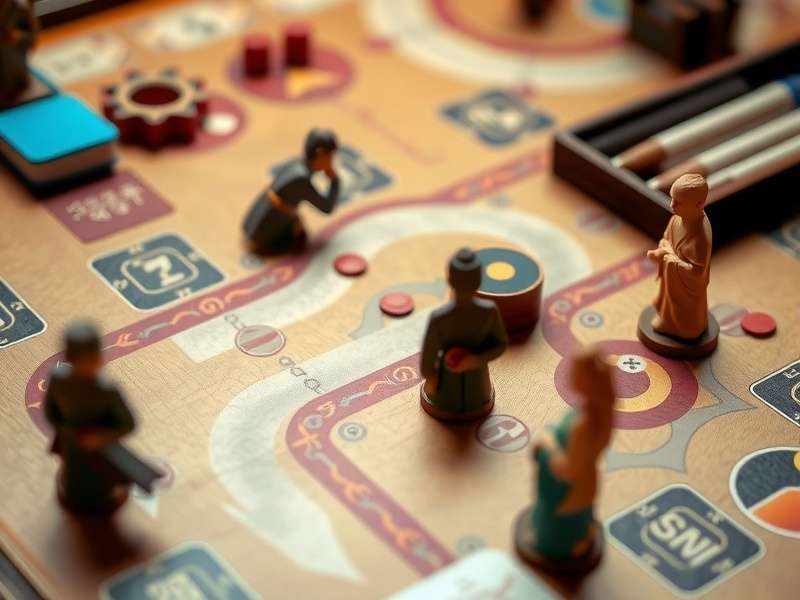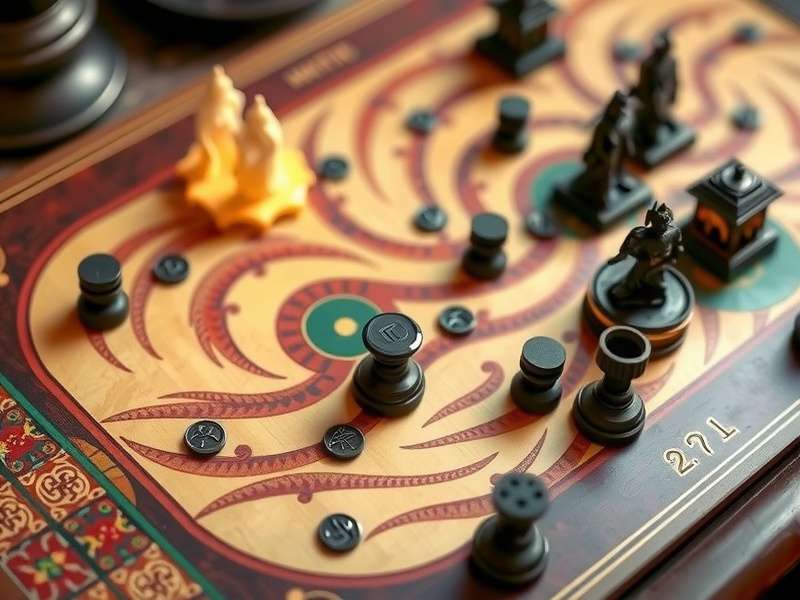Dharma Warrior Path: The Ancient Indian Strategy Game 🎯
Discover the rich history, intricate rules, and profound philosophy behind one of India's most celebrated traditional games
Game Overview
TheDharma Warrior Pathrepresents a pinnacle of traditional Indian strategic thinking, blending elements of warfare, philosophy, and spiritual development into a captivating board game experience. This ancient game has been played for centuries across the Indian subcontinent, with its origins tracing back to the Vedic period.
Unlike Western strategy games that focus primarily on territorial conquest, theDharma Warrior Pathincorporates the fundamental Hindu concept of Dharma - one's righteous duty and moral obligation. Players must balance aggressive expansion with ethical considerations, creating a uniquely Indian approach to strategic gameplay.
🎮 Quick Facts:TheDharma Warrior Pathis typically played on an 8x8 board with distinctive pieces representing different aspects of ancient Indian warfare and society. The game can last anywhere from 30 minutes to several hours, depending on the skill level of the players and the specific variant being played.
The game's enduring popularity stems from its perfect balance between simplicity and depth. While the basic rules can be learned in under an hour, mastery requires years of practice and deep understanding of strategic principles. TheDharma Warrior Pathcontinues to be played in tournaments across India and has gained international recognition in recent decades.

The traditional game board of Dharma Warrior Path, showing the distinctive layout and playing pieces
Historical Origins
The earliest references to games resembling theDharma Warrior Pathappear in ancient Sanskrit texts dating back to approximately 500 BCE. These texts describe a game called "Dharma Yuddha" (Righteous War) that shares many characteristics with the modern version. The game evolved significantly during the Gupta Empire (c. 320-550 CE), when it acquired its current name and most of its standard rules.
Historical records indicate that the game was particularly popular among the Kshatriya (warrior) class, who used it to teach military strategy and ethical decision-making to young warriors. TheDharma Warrior Pathwas considered an essential part of a noble's education, alongside archery, swordsmanship, and Vedic studies.
Vedic Origins
First mentioned in ancient Sanskrit texts around 500 BCE as "Dharma Yuddha"
Gupta Golden Age
Standardized during the Gupta Empire (320-550 CE) with establishment of formal rules
Global Spread
Gained international recognition in the 20th century with formal tournament play
During the medieval period, the game spread throughout Southeast Asia along with Indian cultural influence. Local variants developed in regions such as Indonesia, Thailand, and Cambodia, though the core principles of theDharma Warrior Pathremained consistent. The game experienced a revival during the Indian independence movement, when it was promoted as a symbol of indigenous cultural heritage.
In the modern era, theDharma Warrior Pathhas been recognized by international game associations and has attracted a growing community of enthusiasts outside India. Annual tournaments are held in major Indian cities, and the game is increasingly featured in international strategy game conventions.
Gameplay Mechanics
TheDharma Warrior Pathis played on a square board divided into 64 squares (8x8 grid), though regional variations sometimes use larger 10x10 boards. Each player begins with 16 pieces of six different types, each with unique movement capabilities and strategic values. The objective is to either checkmate the opponent's Raja (king) or achieve a predetermined number of captured pieces.
What distinguishes theDharma Warrior Pathfrom similar strategy games is its incorporation of "Dharma points." Players accumulate these points through ethically sound moves and can spend them to activate special abilities or recover from disadvantageous positions. This mechanic reflects the game's philosophical underpinnings, rewarding players who balance strategic aggression with moral consideration.
Piece Types and Movements
The game features six distinct piece types, each representing a different aspect of ancient Indian warfare and society:
♟️ Raja (King):Moves one square in any direction. The most important piece - if checkmated, the game ends immediately.
♟️ Mantri (Minister):Moves any number of squares diagonally. The most powerful attacking piece after the Gaja.
♟️ Gaja (Elephant):Moves two squares diagonally, jumping over intervening pieces. Represents war elephants.
♟️ Ashva (Horse):Moves in an L-shape (two squares in one direction, then one perpendicular). Similar to knights in Western chess.
♟️ Ratha (Chariot):Moves any number of squares horizontally or vertically. Equivalent to rooks in chess.
♟️ Padati (Foot Soldier):Moves forward one square, captures diagonally. Promotes upon reaching the opposite side of board.
The interaction between these different piece types creates a rich tactical landscape. Successful players of theDharma Warrior Pathmust understand not only how each piece moves, but how they work together in formation and how their relative values change throughout different phases of the game.

Intricately carved traditional pieces used in Dharma Warrior Path, each representing different elements of ancient Indian warfare
Official Rules
The standard rules ofDharma Warrior Pathhave been codified by the International Traditional Games Federation and are used in official tournaments. While regional variations exist, the following rules represent the most widely accepted version of the game.
Setup and Initial Position
Players sit opposite each other with the board positioned so that each player has a light-colored square on their right-hand side. The pieces are arranged in two rows on each side. The back row (closest to each player) is arranged as follows from left to right: Ratha, Ashva, Gaja, Mantri, Raja, Gaja, Ashva, Ratha. The front row consists of eight Padati (foot soldiers).
The player with the lighter-colored pieces (typically sandalwood) moves first. In traditional play, this privilege is determined by random selection, often by concealing a light and dark piece in each hand and having the opponent choose.
Basic Movement and Capture
Players alternate moves, with each move consisting of transferring a piece from its current square to another square according to that piece's movement rules. If a piece moves to a square occupied by an opponent's piece, the opponent's piece is captured and removed from the board.
⚖️ Dharma Points System:Players earn Dharma points through specific ethical moves: protecting threatened pieces (1 point), offering equitable exchanges (2 points), and avoiding unnecessary destruction of opponent's position (1 point per move). These points can be spent to: undo a move (3 points), promote a Padati early (5 points), or protect the Raja from check for one turn (7 points).
The Dharma points system introduces a unique strategic dimension to theDharma Warrior Path, rewarding players who demonstrate foresight, mercy, and strategic patience alongside tactical aggression.
Special Moves and Situations
Several special moves distinguish theDharma Warrior Pathfrom other strategy games:
Dharma Protection:When in check, a player may spend Dharma points to create a "protective aura" around their Raja, nullifying the check for one turn. This can only be used once per game.
Righteous Promotion:When a Padati reaches the opposite side of the board, it is normally promoted to any piece except Raja. With sufficient Dharma points, a player may promote a Padati before it reaches the final rank.
Karma Capture:If a player captures multiple pieces in succession without losing any, they must surrender Dharma points proportional to the imbalance created, reflecting the karmic consequences of excessive aggression.
Advanced Strategy
Mastering theDharma Warrior Pathrequires understanding both conventional strategic principles and the unique elements introduced by the Dharma system. Successful players develop a balanced approach that leverages both tactical aggression and ethical gameplay.
Opening Principles
The opening phase of theDharma Warrior Pathtypically involves controlled development of pieces, securing the center, and ensuring the Raja's safety. Unlike in Western chess, overly aggressive openings are often counterproductive as they may cost valuable Dharma points.
Traditional opening strategies include the "Lotus Formation," which develops pieces in a circular pattern around the Raja, and the "Vajra Attack," which focuses on rapid development of the Gajas and Rathas. The choice of opening often reflects a player's overall strategic temperament.
🧠 Pro Tip:In theDharma Warrior Path, conserving Dharma points in the opening can provide crucial flexibility in the middlegame. Avoid unnecessary captures and consider protecting threatened pieces rather than immediately counterattacking.
Middlegame Tactics
The middlegame is where theDharma Warrior Pathtruly shines tactically. Players must balance piece activity, king safety, pawn structure, and Dharma point accumulation. Common tactical themes include:
Dharma Sacrifice:Intentionally sacrificing material to gain Dharma points or positional advantage. A well-timed sacrifice can completely shift the momentum of a game.
Karmic Pin:Using the threat of Dharma point loss to restrict an opponent's options. By creating situations where captures would be ethically questionable, skilled players can limit their opponent's active possibilities.
Wheel of Fortune Attacks:Coordinated attacks that rotate around a central point, typically the opponent's Raja. These complex maneuvers require precise calculation but can be devastating when executed properly.
Endgame Techniques
The endgame inDharma Warrior Pathoften revolves around the careful use of remaining pieces and Dharma points. With fewer pieces on the board, the relative value of Dharma points increases significantly, as they can often determine the outcome of otherwise equal positions.
Key endgame principles include active piece placement, creating passed Padati, and timing the use of special Dharma abilities. The endgame often rewards players who conserved their Dharma points earlier in the game.

Competitive play in a modern Dharma Warrior Path tournament, showcasing the game's continued relevance
Cultural Significance
TheDharma Warrior Pathholds a special place in Indian cultural heritage, representing a unique synthesis of strategic thinking and philosophical principles. The game embodies core concepts from Hindu philosophy, including Dharma (duty/righteousness), Karma (action and consequence), and Artha (purposeful pursuit of goals).
Throughout Indian history, the game has been used as an educational tool, teaching not only military strategy but also ethical decision-making and foresight. Ancient texts describe rajas and military commanders playing the game to hone their strategic abilities and develop patience.
📜 Historical Anecdote:According to legend, the great emperor Chandragupta Maurya required his military commanders to demonstrate proficiency in theDharma Warrior Pathbefore granting them field command. The game was believed to reveal a commander's strategic temperament and ethical compass.
In contemporary India, theDharma Warrior Pathcontinues to be celebrated as an important cultural artifact. The game is frequently featured in cultural festivals, taught in schools as part of heritage education programs, and studied by game historians interested in non-Western strategic traditions.
The philosophical dimensions of theDharma Warrior Pathhave attracted attention beyond gaming circles. Scholars of Indian philosophy have noted how the game's mechanics reflect classical Indian thought, particularly the concept of "nishkama karma" (action without attachment to results) from the Bhagavad Gita.
Modern Revival and Global Reach
In recent decades, theDharma Warrior Pathhas experienced a significant revival, both within India and internationally. This resurgence can be attributed to several factors:
The establishment of formal tournament structures and governing bodies has provided a competitive framework that has attracted new players. International interest in traditional games has created a global audience for theDharma Warrior Path, with clubs forming in Europe, North America, and East Asia.
Digital adaptations have made the game accessible to players worldwide, with several popular mobile and desktop implementations available. Academic interest in the game's historical and philosophical dimensions has raised its profile in educational institutions.
Today, theDharma Warrior Pathstands as one of India's most significant contributions to world gaming culture, offering a unique perspective on strategy that continues to challenge and engage players across the globe.
Did You Know?
TheDharma Warrior Pathis one of the few traditional games that incorporates ethical decision-making directly into its scoring system, reflecting the deep integration of philosophy and gameplay in Indian cultural traditions.